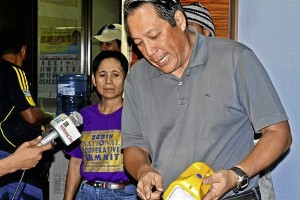Villagers with cell phones but no power get lanterns

SOLAR Energy Foundation chair Jaime Ayala explains how the solar lantern is used to officials and community leaders in one of the country’s remotest areas, Sitio Sabwag of Barangay Kapatagan in Digos City. ELDIE S. AGUIRRE
DIGOS CITY—Dark nights in one of the city’s remotest villages ended early this month as lanterns—powered by solar energy—started to shine in houses there.
At least 36 years since electricity came to this city, its remotest parts have remained literally in the dark. The people of Sitio Sabwag in Barangay Kapatagan had no idea what it was like to have electric bulbs at night, their only light coming from gas lamps.
It is a community so remote that the peak of Mount Apo is just a few kilometers away.
On Feb. 10, all 48 households there switched on their light bulbs, courtesy of Solar Energy Foundation.
The remoteness of the place did not deter Jaime Ayala, the Solar Energy Foundation chair, from personally delivering the lamps.
Article continues after this advertisementAyala led 38 climbers from Kaya ng Pinoy Foundation to Sitio Sabwag and distributed the solar lanterns to 48 households. He was accompanied by Mayor Joseph Peñas, Vice Mayor Reynaldo Hermosisima, Kapatagan village chief Juanito Morales and other local officials.
Article continues after this advertisementAyala said the foundation chose solar-powered lanterns because these are “much superior to conventional battery-operated flashlights.”
According to Ayala, the solar lanterns could provide illumination for nine to 100 hours depending on use. The lanterns, he said, could also charge cell phones.
Village chief Morales said some residents of Sitio Sabwag, despite the lack of electricity, own cell phones which they use to communicate with relatives living in other areas.
He said residents walk several kilometers to the nearest village with electricity to charge their phone batteries. “That ends now, too. The lanterns can well do that for them,” he said.
Morales said the most important purpose of the lanterns is to provide light for students studying at night in the remote community. “Previously, they gather around the family’s gas lamp to do that,” he said.
Ayala said since 2011, Solar Energy Foundation has been distributing solar lanterns to the country’s remotest areas.
He said so far, solar-powered lanterns have been distributed to communities living in Mt. Apo, Mt. Dulang-Dulang, Mt. Canlaon, Mt. Pulag and Mt. Guiting-Guiting.
Art Valdez, of Kaya ng Pinoy Foundation, said the group put to use its members’ enthusiasm for trekking to help those living near the six tallest mountains in the country.
“The climbers are helping spread the foundation’s mission of providing sustainable access to energy in the most remote nooks in the country,” Ayala said.